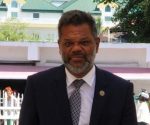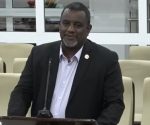Short-term measures needed for Pond Island Landfill
Dear Editor,
This week the Nature Foundation announced that due to the landfill on Pond Island which has been burning for over a month, the non-governmental organization (NGO) has called on nearby communities to start wearing facemasks in order to protect themselves from the fumes. The NGO on Thursday distributed masks to students and staff of a school on the Pondfill which is located near the landfill.
The Nature Foundation also stated that the month long fire is now resulting in significant negative health effects affecting the community and visitors alike. “As we still wait for action to occur regarding the management of our solid waste issues, we encourage that especially expectant mothers and those with a weakened immune system wear facemask to reduce the risk caused by the landfill,” the Nature Foundation said this week.
As long as the landfill has no system for the collection of methane gas, and no proper closure or packing of waste, there will be fires.
According to some Waste Management specialist, the average landfill site has a 60 per cent statistical risk of fire each year. The cost of preventing a landfill fire is far less than extinguishing it.
The longer a fire burns the more difficult it is to put out and will burn for a long time. With the Pond Island landfill fire already burning for over a month, are we looking at this being the new norm for 2018?
Waste Management specialist say that landfill fires cannot be left to burn (smoulder) due to the dangerous emissions, including dioxins that are given off by slowly combusting PVC, among other substances.
There are two types of landfill fires, surface, or shallow fires and deep seated fires. Surrounding communities of Pond Island have observed the billowing black/grey smoke from the surface fires on the landfill. This was very common in 2017 and 2016.
Surface fires can be ignited by lightning, hot coals entering the landfill in the waste stream among many others. To deal with such a fire, the waste management company would place a layer of material such as top soil on the fire and compact it with a landfill compactor. Another technique is to douse it with a lot of water.
Treating underground landfill fires involves infiltrating an inert gas such as CO2 or nitrogen into the area where the fire is emanating from.
Short-term measures are needed now to protect public health. It has been stated in the media that the new Waste to Energy Facility will take 18-months before it is operational. In the meantime, something should be done until the facility is fully functional.
The United Nations (UN) Environment and World Health Organization (WHO) have agreed a new, wide-ranging collaboration to accelerate action to curb environmental health risks that cause an estimated 12.6 million deaths a year.
An agreement has been signed by the two aforementioned entities to step up joint actions to combat air pollution, climate change and antimicrobial resistance, as well as improve coordination on waste and chemicals management, water quality, and food and nutrition issues. The collaboration also includes joint management of the BreatheLife advocacy campaign to reduce air pollution for multiple climate, environment and health benefits.
This represents the most significant formal agreement on joint action across the spectrum of environment and health issues in over 15 years, according to the two international organizations.
“There is an urgent need for our two agencies to work more closely together to address the critical threats to environmental sustainability and climate – which are the foundations for life on this planet. This new agreement recognizes that sober reality,” said UN Environment’s Solheim said.
“Our health is directly related to the health of the environment we live in. Together, air, water and chemical hazards kill more than 12.6 million people a year. This must not continue,” said WHO’s Tedros.
It’s overdue, and it’s time for some form of action on the Pond Island landfill.
Roddy Heyliger























